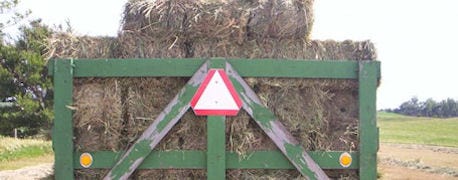August 12, 2013

The size and weight of agricultural equipment and the potential impact it has on public roads is the subject of a series of town hall meetings to be held throughout the state in the next month.
The Wisconsin Department of Transportation and Department of Agriculture, Trade and Consumer Protection are urging the agricultural community, local highway officials and others to attend the meetings. Sessions will provide detailed information on the recommendations of a special study group that reviewed size and weight limits and other issues related to agricultural equipment, also known as implements of husbandry.

Meetings Around the State Set to Review Impacts of Farm Equipment on Roads
Agricultural equipment is getting larger and heavier which helps in more efficient farm production, but it can also impact pavement and road structures. That's why WisDOT, in partnership with DATCP, convened the IoH Study Group. It involved over 20 stakeholders representing various transportation and farm organizations, equipment manufacturers, law enforcement, local officials and the University of Wisconsin-Madison/Extension.
"We recognize that agriculture is a vital element of our state's economy, but there are limits for our roadway infrastructure that are defined by physics and safety," says Rory Rhinesmith, deputy administrator of WisDOT's Division of Transportation System Development and chair of the study group. "IoH equipment can't exceed the capacity of our roads and bridges and must be able to safely operate with other road users. Our approach was to bring together a knowledgeable group of people committed to finding a balanced solution based on science and the needs of the agricultural community."
"DATCP was pleased to partner with WisDOT on this effort. I hope farmers and other citizens will attend the town hall meetings to get a better understanding of the recommendations," says Jeff Lyon, DATCP deputy secretary. "The group came up with several options that could lessen the impact on our roads. Obviously, there needs to be a balance between the needs of farming and other road users."
Two of the more challenging issues for the study group were establishing maximum size and gross vehicle and axle weight limits. Some of the group's recommendations include:
* Maximum width of IoH equipment of 15 feet. Equipment up to 17 feet wide may be operated without written authorization when they meet safety requirements to ensure safe passage by other road users.
* Maximum width of IoH commercial motor vehicles of 10 feet.
* Maximum height of 13 feet 6 inches. Equipment greater than this height may be operated without written authorization. The operator is responsible for ensuring there are no conflicts with overhead obstructions such as wires or structures.
* Maximum length of 60 feet for single IoH equipment; 100 feet for combinations of two IoH and 70 feet for a combination of three IoH.
~~~PAGE_BREAK_HERE~~~
Expanding the weight allowance for IoH up to 15% over the limits established by the Federal Bridge Formula except where posted or during spring thaw.
Safety, the capacity of roads and bridges and consideration of commonly used IOH equipment guided the recommendations for size. Road width, overhead wires, bridge standards and the ability to safely maneuver through turns determined the new size parameters. The recommendation on weight allowance is based on engineering analysis and research on the damage done to roads as a result of increased weight.
The town hall meetings will offer a chance to ask questions and provide feedback on the proposed size and weight limits. In addition, the meetings will share other recommendations such as new definitions for IoH, operator requirements for vehicles that exceed base definitions and best practices such as pipelines, nurse trucks and one-way roads.
All of the meetings, co-hosted by the University of Wisconsin Extension, will take place from 7 to 8:30 p.m. on the dates and locations listed below:
Aug. 19 – UW Extension Office, 5201 Fen Oak Drive, Madison
Aug. 20 – Country Aire Banquet Hall, F1312 County Road P, Stratford
Aug. 28 – Cashton Community Hall, 8111 Main Street, Cashton
Aug. 29 – WisDOT Northeast Region Office, 1940 West Mason Street, Green Bay
Sept. 3 – Chippewa County Courthouse Large Assembly Room, 711 North Bridge Street, Chippewa Falls
If you are unable to attend the meeting and would like more information or to comment, contact Rory Rhinesmith, deputy administrator, Division of Transportation System Development at (608) 267-7111. Written comments regarding the project can be mailed to Mr. Rhinesmith, WisDOT, 4802 Sheboygan Avenue, Room 451, P.O. Box 7910, Madison, WI 53707-7910. The meeting sites are accessible to wheelchairs. Citizens who are deaf or hard of hearing and require an interpreter should call at least three working days prior to the meeting.
The complete IoH Study Group report is online. An online feedback survey will be available Aug. 14. Check the web site for details.
Source: DATCP
You May Also Like




